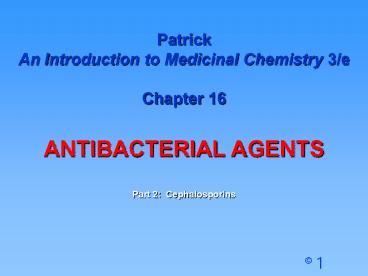Patrick PowerPoint PPT Presentation
Title: Patrick
1
Patrick An Introduction to Medicinal Chemistry
3/e Chapter 16 ANTIBACTERIAL AGENTS Part 2
Cephalosporins
2
CEPHALOSPORINS
3
1. Introduction
- Antibacterial agents which inhibit bacterial cell
wall synthesis - Discovered from a fungal colony in Sardinian
sewer water (1948) - Cephalosporin C identified in 1961
4
2. Structure of Cephalosporin C
7-Aminoadipic side chain
5
3. Properties of Cephalosporin C
- Disadvantages
- Polar due to the side chain - difficult to
isolate and purify - Low potency - limited to the treatment of urinary
tract infections where it is concentrated in the
urine - Not absorbed orally
- Advantages
- Non toxic
- Lower risk of allergic reactions compared to
penicillins - More stable to acid conditions
- More stable to b-lactamases
- Ratio of activity vs Gram -ve and Gram ve
bacteria is better
- Conclusion
- Useful as a lead compound
6
4. Biosynthesis of Cephalosporins
7
5. SAR of Cephalosporins
- Similar to penicillins
- The b-lactam ring is crucial to the mechanism
- The carboxylic acid at position 4 is important to
binding - The bicyclic system is important in increasing
ring strain - Stereochemistry is important
- The acetoxy substituent is important to the
mechanism - Possible modifications
- 7-Acylamino side chain
- 3-Acetoxymethyl side chain
- Substitution at C-7
8
6. Mechanism of Action
- The acetoxy group acts as a good leaving group
and aids the mechanism
9
7. Variation of the 7-Acylamino Side Chain
- Not possible to generate analogues by
fermentation - Not possible to generate analogues by a full
synthesis - Restricted to semi-synthetic procedure
- 7-ACA not available by fermentation
- 7-ACA not available by enzymatic hydrolysis of
cephalosporin C
- Generated by a chemical hydrolysis
10
7. Variation of the 7-Acylamino Side Chain
- Generation of 7-ACA
- Need to hydrolyse a relatively unreactive
secondary amide in the presence of a labile
b-lactam ring
11
8. First Generation Cephalosporins
Cephalothin
- First generation cephalosporin
- More active than penicillin G vs. some Gram -ve
bacteria - Less likely to cause allergic reactions
- Useful vs. penicillinase producing strains of S.
aureus - Not active vs. Pseudonomas aeruginosa
- Poorly absorbed from GIT
- Administered by injection
- Metabolised to give a free 3-hydroxymethyl group
(deacetylation) - Metabolite is less active
12
8. First Generation Cephalosporins
Cephalothin - drug metabolism
Less active OH is a poorer leaving group
- Strategy
- Replace the acetoxy group with a metabolically
stable leaving group
13
8. First Generation Cephalosporins
Cephaloridine
- The pyridine ring is stable to metabolism
- The pyridine ring is a good leaving group
(neutralisation of charge) - Exists as a zwitterion and is soluble in water
- Poorly absorbed through the gut wall
- Administered by injection
14
8. First Generation Cephalosporins
Cefalexin
- The methyl group at position 3 is not a good
leaving group - The methyl group is bad for activity but aids
oral absorption - mechanism unknown - Cefalexin can be administered orally
- A hydrophilic amino group at the a-carbon of the
side chain helps to compensate for the loss of
activity due to the methyl group
15
8. First Generation Cephalosporins
Synthesis of cephalosporins with a 3-methyl
substituent
16
8. First Generation Cephalosporins
Summary
- Generally lower activity than comparable
penicillins - Better range of activity than comparable
penicillins - Best activity is against Gram-positive cocci
- Useful against some Gram negative infections
- Useful against S. aureus and streptococcal
infections when penicillins have to be avoided - Poorly absorbed across the gut wall (except for
3-methyl substituted cephalosporins) - Most are administered by injection
- Resistance has appeared amongst Gram negative
bacteria (presence of more effective
b-lactamases)
17
9. Second Generation Cephalosporins
9.1 Cephamycins
Cephamycin C
- Isolated from a culture of Streptomyces
clavuligerus - First b-lactam to be isolated from a bacterial
source - Modifications carried out on the 7-acylamino side
chain
18
9. Second Generation Cephalosporins
9.1 Cephamycins
Cefoxitin
- Broader spectrum of activity than most first
generation cephalosporins - Greater resistance to b-lactamase enzymes
- The 7-methoxy group may act as a steric shield
- The urethane group is stable to metabolism
compared to the ester - Introducing a methoxy group to the equivalent
position of penicillins (position 6) eliminates
activity.
19
9. Second Generation Cephalosporins 9.2
Oximinocephalosporins
Cefuroxime
- Much greater stability against some b-lactamases
- Resistant to esterases due to the urethane group
- Wide spectrum of activity
- Useful against organisms that have gained
resistance to penicillin - Not active against P. aeruginosa
- Used clinically against respiratory infections
20
10. Third Generation Cephalosporins
Oximinocephalosporins
- Aminothiazole ring enhances penetration of
cephalosporins across the outer membrane of Gram
-ve bacteria - May also increase affinity for the
transpeptidase enzyme - Good activity against Gram -ve bacteria
- Variable activity against Gram ve cocci
- Variable activity vs. P. aeruginosa
- Lack activity vs MRSA
- Generally reserved for troublesome infections
21
10. Third Generation Cephalosporins
Oximinocephalosporins
Ceftazidime
- Injectable cephalosporin
- Excellent activity vs. P. aeruginosa and other
Gram -ve bacteria - Can cross the blood brain barrier
- Used to treat meningitis
22
11. Fourth Generation Cephalosporins
Oximinocephalosporins
- Zwitterionic compounds
- Enhanced ability to cross the outer membrane of
Gram negative bacteria - Good affinity for the transpeptidase enzyme
- Low affinity for some b-lactamases
- Active vs. Gram ve cocci and a broad array of
Gram -ve bacteria - Active vs. P. aeruginosa

